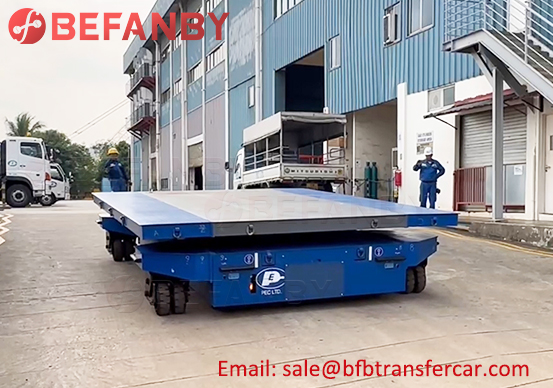How To Automate Trackless Transfer Trolley?
The automation of trackless transfer trolleys mainly depends on their advanced control systems and guidance technologies. BEFANBY summarizes the following key aspects of automation:
1. Control System
The control system of trackless transfer trolley is usually divided into ground control systems and on-board control systems.
Ground control system: As the core of the entire system, it is mainly responsible for tasks allocation, trackless transfer trolley scheduling, path (line) management, traffic management, and automatic charging. The ground control system can monitor the location, status, and task execution of the vehicle in real time, and communicate with the on-board control system through a wireless network.
On-board control system: After receiving instructions from the ground control system, it is responsible for performing navigation calculations, guidance implementation, trackless transfer trolley travel, loading and unloading operations, and other functions of contactless power supply automated trackless transfer trolley. The on-board control system can ensure that the trackless transfer trolley travels according to the preset route and speed, and adjusts in real time to cope with possible obstacles or traffic changes.
2. Guidance Technology
Trackless transfer trolley usually use electromagnetic automatic guidance devices (such as magnetic nail guidance) to achieve automatic guidance.
Magnetic nail guidance: By laying magnetic nails on the preset driving route and installing magnetic nail readers on the vehicle, the trackless transfer trolley can sense the position and signal strength of the magnetic nails in real time, thereby determining its own position and driving direction. The seamless cooperation between the magnetic nail reader and the magnetic nail can adapt to the needs of complex running routes.


3. Automation Function Realization
Automatic driving: Through the cooperation of the on-board control system and guidance technology, the trackless transfer trolley can automatically drive along the preset route without manual driving.
Automatic loading and unloading: The on-board control system can communicate with loading and unloading equipment (such as forklifts, stackers, etc.) to realize automatic loading and unloading of goods and improve loading and unloading efficiency.
Automatic obstacle avoidance: Through the equipped sensors (such as laser radar, cameras, etc.), the trackless transfer trolley can sense obstacles in the surrounding environment in real time and automatically take obstacle avoidance measures to ensure driving safety.
Automatic charging: When the ground control system detects that the vehicle is low on power, it can automatically dispatch the trackless transfer trolley to the charging station for charging without manual intervention.
4. Automation Advantages
Improve transportation efficiency: Trackless transfer trolleys can carry out transportation operations continuously and energy-efficiently, reducing the time and cost of manual operations.
Improved safety: Automated trackless transfer trolleys are equipped with a variety of safety devices and sensors, which can sense obstacles in the surrounding environment in real time and automatically avoid obstacles, reducing the risk of accidents.
High flexibility: The trackless steering design enables the trackless transfer trolley to travel flexibly in various complex environments and adapt to different transportation needs.
In summary, trackless transfer trolleys have achieved automation through advanced control systems and guidance technologies, improving transportation efficiency, safety and flexibility.




